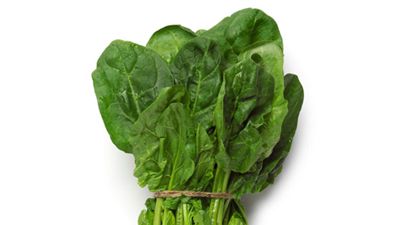The Girl's Guide to Eating Green
News flash: Going organic shouldn't require a trust fund or a Ph.D. in botany. We quizzed the experts and scoured the produce aisles to devise a healthy, eco-friendly action plan suitable for everyone.GREEN LINGO: A GROCERY STORE PRIMERFACT OR FICTION? 5 GREEN-EATING MYTHS

The Low-Maintenance GreenieYou know the healthy-eating basics: Refined carbohydrates, bad. Fresh vegetables, good. But you work long hours and barely have three minutes to nuke a Lean Cuisine, much less sauté an herbaceous medley for dinner. While you like the idea of buying more organic food, it sounds pricey—and you haven't gotten a raise in almost two years.
WHERE TO SHOP:
No need to ditch your favorite grocery store. About 75 percent of American supermarkets carry some organic food, and many of the big chains boast their own affordable organic brands (e.g., Safeway's O Organics, Stop & Shop's Nature's Promise). Stick to the periphery of the store—the most heavily processed foods are shelved in the middle. Imagine you're trolling the aisles with your great-grandma in tow, suggests sustainable-eating guru Michael Pollan in his book In Defense of Food (required reading for the au naturel set). If she wouldn't recognize something as food—read: Gummi Bears or Cap'n Crunch—think twice before picking it up.
YOUR GREEN GROCERY LIST:
Organic meats and dairy foods. The pesticides that collect in the fatty tissue of conventionally farmed meat products are fat-soluble, so they can stay in your body for years (unlike the pesticides on produce, which we eliminate relatively quickly). Plus, nonorganic meats and dairy products are loaded with antibiotics and growth hormones.
Domestic produce. "Chemicals banned in the U.S. often get sold to other countries and sent back to us as residue on fruits and vegetables," says Jennifer Sass, a scientist at the Natural Resources Defense Council. Last year, Congress passed a law requiring country-of-origin labeling on all produce. Look for it. And play it safe: Even if an apple is from New York, wash it well—and peel it, if possible.
Whole-grain foods. Most have fewer additives than processed white pastas and breads. Even Saltines contain high-fructose corn syrup.
Get exclusive access to fashion and beauty trends, hot-off-the-press celebrity news, and more.
NEXT PAGE >> -->
The Up-and-Coming Greenie
You're a Daily Green denizen hungry for some serious dietary changes—both for your own well-being and the Earth's. Proof of your commitment: Your freezer is packed with Boca burgers, and you always recycle (well, at least paper and plastic). Although going übergreen will consume more of your time and money, you're willing to go the extra mile—or maybe another block or two.
WHERE TO SHOP:
Make at least one trip per week to your local farmers' market. They have more than doubled in number over the past 15 years, to more than 4600 nationwide. (Visit localharvest.org to find one near you.) In addition to fresh meat and dairy, these markets sell produce that was likely picked within the last 48 hours. Just don't assume all of the offerings are organic. It's expensive to get certified by the USDA, so small farms can't always afford to. When they do, you'll probably notice that investment reflected in their prices. If you don't see an organic seal, ask the farmer whether she uses pesticides, synthetic fertilizers, or antibiotics. In other words, "Shake the hand that feeds you," advises Pollan.
YOUR GREEN GROCERY LIST:
Organic produce, starting with whatever you eat most often. Keep in mind the Environmental Working Group's "dirty dozen"—fruits and veggies found to have the most pesticide residue, even after washing: peaches, apples, sweet bell peppers, celery, nectarines, strawberries, cherries, kale, lettuce, imported grapes, carrots, and pears. It's fine to buy nonorganic, thick-skinned fruits like avocados, bananas, and pineapples.
Locally grown food. The fewer miles a piece of produce has traveled, the riper (and tastier and more nutritious) it will be.
Omega-3-rich fish. Cut your meat consumption in half and replace those proteins with fish like wild salmon and trout. Avoid farm-raised salmon (full of banned PCBs) and canned albacore tuna (loaded with mercury).
NEXT PAGE >> -->
The Hard-Core Greenie
You wear canvas kicks, charge your MacBook from inside your solar backpack, and keep a dog-eared copy of Alice Waters's The Art of Simple Food on your nightstand. You're passionate about reducing the environmental impact of your diet, and you're itching to get some dirt under your fingernails.
WHERE TO SHOP:
Augment your pantry by joining a CSA (community-supported agriculture)—a food co-op whose members buy "shares" in a local farm (generally starting at about $50 a month) and in return receive a box of its produce each week. The food doesn't get much fresher or more local. The downside: You get whatever they deliver, even if you can't pronounce it (it's kohl-rah-bee). Consider growing your own food. With even less than 200 square feet of outdoor space, you can harvest greens, tomatoes, cucumbers, and beans. Plant herbs in a pot on your fire escape—rosemary and parsley do pretty well year-round. Or take advantage of one of the 18,000 community gardens peppered across the country. To find one near you, visit the American Community Gardening Association website (communitygarden.org).
YOUR GREEN GROCERY LIST:
Raw ingredients. Make your own yogurt, granola, and bread from scratch. (Start buying organic cookbooks and experiment with the recipes.)
Beans. Buh-bye, all-beef patties. You're now a die-hard vegetarian who scores her protein from black beans, chickpeas, and lentils.
DIY composting kit. It's not as icky as it sounds, we promise. There are countless websites devoted to the safe and clean composting of your produce refuse.